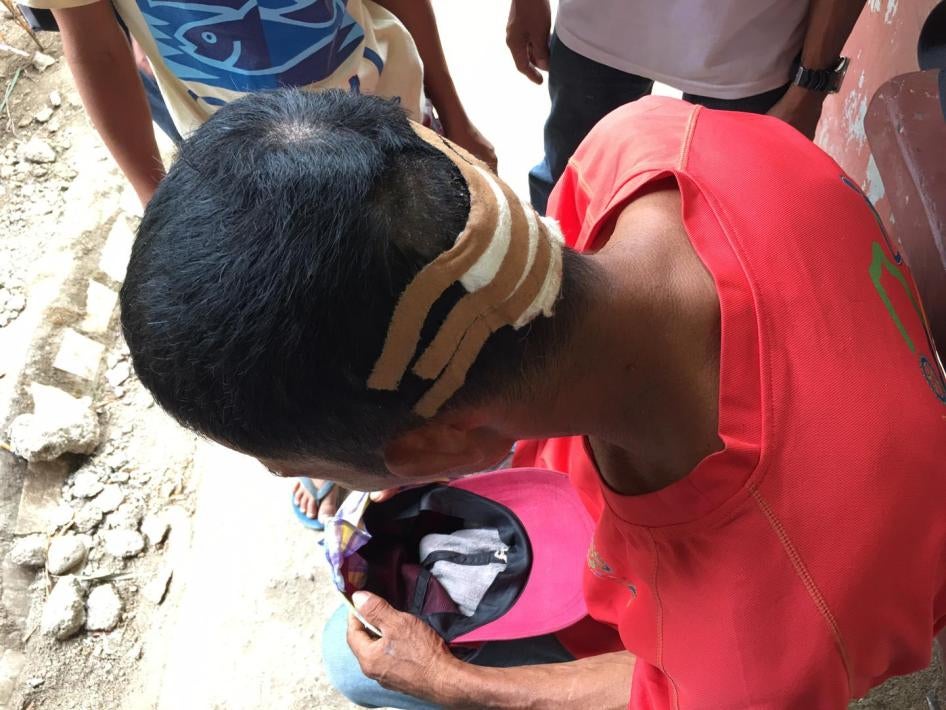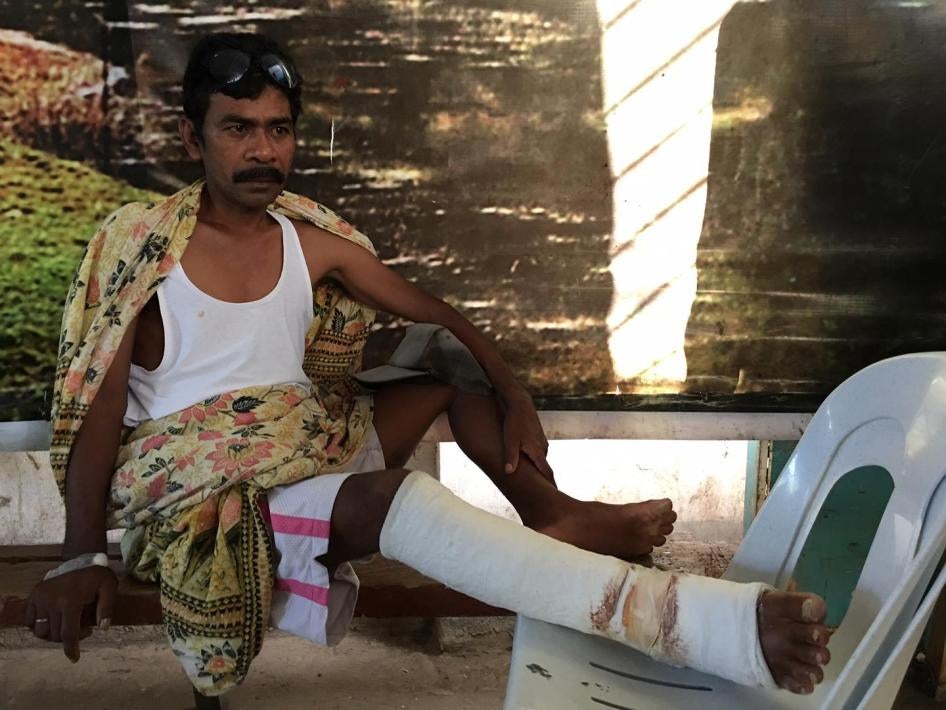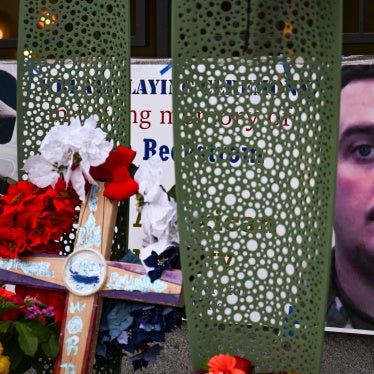(Kidapawan City) – The Philippine police may have used unnecessary lethal force in breaking up a demonstration by farmers in Kidapawan City on April 1, 2016, Human Rights Watch said today. The police used batons and guns against the protesters, including women and children, some of whom threw rocks at the police.
Darwin Sulang, 22, and a bystander, Enrico Fabligar, 30, were fatally shot, and dozens who were injured required hospitalization for gunshot and other wounds. The police also reported injuries to their officers. Police have detained 79 protesters and charged 74 of them with offenses including assaulting a police officer. Three separate investigations into the incident are underway by the official Commission on Human Rights, the Philippines National Police, and the Senate Committee on Justice and Human Rights.
“The Philippine government needs to determine why the police found it necessary to fire at protesters,” said Phelim Kine, deputy Asia director. “Some protesters were throwing stones, but lethal force may only be used as a last resort to save lives.”
Human Rights Watch interviewed eyewitnesses to the protests, and called for the government to ensure that investigations into police use of force are credible, transparent, and impartial.
Some 6,000 protesters, primarily farmers and supporters from drought-stricken areas in North Cotabato and Bukidnon provinces on the southern island of Mindanao, gathered in Kidapawan City beginning March 28, calling for government food aid and other assistance. On March 30, the group protested by blocking the main highway into the city. On April 1, Philippine National Police personnel, some with riot shields and helmets, led an operation to clear the protesters from the road, backed by a Special Weapons and Tactics (SWAT) unit equipped with military-style body armor and M-16 assault rifles.
Witnesses told Human Rights Watch that the police began donning their crowd-control gear at about 9 a.m. on April 1. Minutes after the crowd was ordered to disperse, a phalanx of police officers and SWAT unit personnel used batons to push through the crowd. When protesters responded by throwing rocks, fire trucks used water cannons against the stone-throwers. A video shows protesters advancing toward the police followed by apparently uncoordinated gunfire that continues sporadically.
Since the incident, local and national government officials have alleged that groups linked to the insurgent communist New People’s Army organized the protest. Protesters have denied any such links.
The mayor of Kidapawan City, Joseph Evangelista, told Human Rights Watch that he tried to negotiate a peaceful resolution of the protest with the assistance of the local Catholic diocese beginning March 30, but said that protest organizers refused to meet. He described the police decision to fire into the crowd as “warning shots” intended to protect two policemen allegedly “about to be killed” by protesters.
The North Cotabato police chief, Alex Tagum, said that police fired on protesters “to defend the people who are helpless and about to be killed,” but provided no details. Police Superintendent Jerson Berrey, who supervised the police operation, said police had “reliable reports that there were armed elements that [were] maybe accompanying the [protesters].” He said that this concern, along with Kidapawan City’s history of being “very prone to terror attacks and bus burnings and kidnappings,” prompted him to order the deployment of a SWAT unit to help deter potential “terror attacks and [situations in which] the police will be made sitting ducks.” Human Rights Watch has been unable to confirm Berrey’s assertion of possible “armed elements” among the protesters.
The nongovernmental Health Alliance for Human Rights reported at a press conference on April 6, that at least 40 protesters sustained injuries, 30 of them gunshot wounds. Human Rights Watch was not able to corroborate those numbers because police and hospital administrators have blocked access by media and human rights researchers to local hospitals where injured protesters are undergoing treatment. However, Human Rights Watch interviewed six injured protesters who either remained at the scene of the shootings or were held by the police at the city gym. They included two protesters with gunshot wounds to the leg and ankle, and four others with heavily bruised arms, torsos, and faces that they alleged were inflicted by police wielding truncheons and rifle butts.
Neither local government officials nor the Kidapawan City police have released details of the numbers of protesters injured or the type or severity of those injuries. The Philippine National Police in Manila reported on April 3, that nearly 100 policemen were also injured at the protest site on April 1. They include an officer currently in the intensive care unit of the Kidapawan Doctors Hospital with severe head injuries that police allege was the result of a beating by protesters. A video from a police aerial drone appears to show a protester repeatedly striking a policeman with a board.
An estimated 1,500 protesters remain in Kidapawan City and have taken shelter inside the Spottswood Methodist Center (SMC) and are refusing to leave for fear of police harassment and possible arrest. Police blocked the entrance of the center from April 1 to April 5, requiring all those entering and exiting the compound to record their identities in a police logbook and to submit to a body search and examination of their belongings.
On April 1, the municipal and provincial governments threatened the Methodist Church and Methodist Bishop Ciriaco Francisco with possible legal action if protesters continued to be given sanctuary at the SMC compound. On April 5, Philippine military personnel from the 39th Infantry Battalion began patrolling and taking video footage inside the SMC compound in what church officials have called deliberate harassment of the protesters and church workers.
“In Kidapawan, a difficult situation got out of control,” Kine said. “Transparent and impartial investigations are needed to find out what went wrong, who should be held accountable, and what is needed to restore trust in the police.”
I joined the barricade because we were told that we could get rice. Our place was really suffering from the drought. I have two kids and we can’t feed them properly. They were becoming sick. We often would just eat root crops because all the plants around us have died.
Rey Suat, 46, a farmer from Magpet town, in North Cotabato, said:
I joined because the situation in our village was really dire. We were told that we might be able to get rice if we go down to Kidapawan City. I have eight children and I pity them because we haven’t had rice for a long time and all we were eating were sweet potatoes and bananas. My youngest is 6 and we could only eat rice once a day. Three months into the drought, our plants – rice and corn – started dying. We have no other means of livelihood. We came here because all we wanted was rice and help from the government.
Lomeriano Agustin, Jr., 47, from Kitaotao town, Bukidnon province, said:
[Neighbors] convinced us that [presidential candidate Rodrigo] Duterte was coming and that the rice was already there and that it was just a matter of distributing it. We needed help.
Arnel Takyawan, 45, from Antipas town, North Cotabato, said that an indigenous people’s organization told him and his fellow villagers to go to Kidapawan because the provincial governor, Emmylou Taliño-Mendoza, might distribute free rice to drought victims:
We were really hard-up because of the drought. The waters have run dry. Our crops are dead. Our fields are dead. My young children – I have five – were suffering. So when we heard about this, we readily came. We didn’t come here for trouble.
Protesters and witnesses describe the shooting incident
Three employees of a business nearby the protest site witnessed the incident. One of them, “Rick” (a pseudonym), told Human Rights Watch:
The protest had been peaceful since it started. Trouble only erupted when the police started dispersing them. I did not hear gunshots coming from the side of the protesters. I did not see anybody shooting. The police had been taunting the protesters with insults from their loudspeakers since Wednesday [March 30], when the protesters started to block the highway and were just there making speeches, singing songs. The police even said that they would give them five minutes to leave the highway, but they moved in even before the five minutes were finished. It was so scary. We ran inside the hotel, especially when the firing started.
Efren Marapan said he was having breakfast on April 1, when he heard the police announce via loudspeaker that everyone should leave the area because negotiations between protest organizers and the government had failed:
Around 9 a.m., the police started removing the tarps that were covering their [shields and truncheons] on the highway. Moments later, [the police] started coming at us. One of the police struck me with a truncheon in the left side of my torso. I saw one of them throw a rock at me, but he missed. One of my companions, Jonathan, was struck in the head though. I saw a police officer being hit in the head [by a protester]. Stones and rocks were raining. Even the women were throwing rocks. And then we heard gunshots, one after the other. I saw SWAT members around 20 meters away, in the front and side, armed with M-16s, some of them on the ground, firing at us. I ran toward an electric post to take cover, near a fire truck. A man beside me was hit by a bullet in the knee. Another was hit in the neck. Another was struck in the foot. It went on for about 10 to 15 minutes before we decided to retreat.
Rey Suat said:
A rock hit me in the back of the head as I was running away. A bullet grazed [my friend] Ricky’s forehead. The firing was not rapid, not automatic shots. Each rang out in intervals. I saw police officers on top of the firetrucks although I did not see any of them shooting. But the ones I saw hiding behind the fire trucks were shooting at people. They were wearing masks and helmets.
Malbert Magdato, 23, a protester from Magpet, North Cotabato, said:
A police officer struck protesters with his truncheon. One of them was hit in the back of the head. They were kicking us, pushing us. It was chaotic. From my left side, I saw four police officers drop to the ground and started shooting. Some of my companions were shot in the leg. We fought back, threw stones and destroyed one fire truck. When the rocks just kept coming, the police moved away. Some of them also threw rocks at us. But the shots kept coming.
“Kris” (a pseudonym), a 16-year-old child protester, said:
I and the person beside me were retreating and running away, but the snipers started firing and some of my friends were hit. I felt a bullet miss my foot by a few inches. Some of us went back to help the wounded. I saw about five police officers shooting at us. We decided to fight back because we were so mad.
Mike Impit, 49, a protester from Amabel village, in Magpet town, North Cotabato, said:
I was shot in the left leg as I was running away. I was shot the moment I turned my back to run. I did not expect this to happen to us. We just came here for the rice.
Arnel Takyawan, 45, a farmer from Camutan village, Antipas town, North Cotabato, said:
From around 50 meters away, SWAT officers were on top of fire trucks. I was looking for my friends when I felt a bullet [pass] a few inches from my chest. I looked up [and] saw a SWAT officer on top of the fire truck taking another aim at me. I turned around to run, but was struck by the second shot in my right foot. I felt my right foot getting heavy and I fell to the ground.
Lomeriano Agustin, Jr., 47, from Kitaotao town, Bukidnon province, said:
I was very near Darwin Sulang [one of the two fatalities], probably an arm’s length, when a bullet struck him in the left temple. I thought he was just taking cover or picking up rocks to throw at the police when he fell to the ground. I jumped for cover behind one of the trees, but a policeman ran towards me, grabbed me and handcuffed me. He was shouting, “You think you’re tough?! You think you’re tough?!” The police officer hit me with a truncheon several times in my left arm, right shoulder, lower back, and his face. I had blood all over. The officer then grabbed me by my belt and collar and pushed me into a police car like I was a pig. The officer threw my bag with my clothes, money and cellphone into the fire that I had prepared that morning to cook food.
“Gemma” (a pseudonym), is an employee of a business nearby to where the shooting occurred. She witnessed the death of Enrico Fabligar, a bystander shot during the incident:
When the firing started, Fabligar ran toward us in front of the hotel to seek cover but he was hit in his right side. The shooter, a police officer, was crouching there [pointing to a line of drainage culverts about 15 meters from the hotel entrance]. He even managed to reload a magazine into his firearm. I saw it with my own eyes.
Relevant legal standards
The 2013 National Handbook of the Philippine National Police, under its operation procedures on rallies and demonstrations, states that member of the police’s Civil Disturbance Management (CDM) contingent “shall be in prescribed uniform without firearm.” The handbook prohibits a police officer from “obstructing, impeding, disrupting or otherwise denying the exercise of the right to peaceful assembly” and “the unnecessary firing of firearms to disperse the public assembly.” It also prohibits the carrying of firearms by anybody, including members of the CDM contingent, within 100 meters of the protest area.
Section 10 of the Public Assembly Act of 1985 also prohibits law enforcers from carrying “any kind of firearms” when deployed to protests and demonstrations. The “unnecessary firing of firearms by a member of any law enforcement agency or any person to disperse the public assembly” violates section 13 of this law. SWAT units, which are part of the police, are covered by these regulations.
The United Nations Basic Principles on the Use of Force and Firearms by Law Enforcement Officials, which set out international law on the use of force in law enforcement situations, provide that police and other security forces shall as far as possible apply nonviolent means before resorting to the use of force. Whenever the lawful use of force is unavoidable the authorities should use restraint and act in proportion to the seriousness of the offense. Lethal force may only be used when strictly unavoidable to protect life. Governments shall ensure that arbitrary or abusive use of force and firearms by law enforcement officials is punished as a criminal offense.











